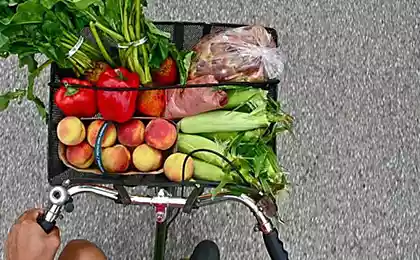894
Intuitive nutrition in the family: where to start
Intuitive nutrition is gaining more popularity in the Russian-speaking space. And no wonder — we are increasingly faced with the unpleasant consequences of the desire to eat only correctly — in the network there were even the popular term “proper nutrition of the brain”, meaning excessive desire to make your diet “healthy”, usually alternating with nutritional breakdowns — short feasts “forbidden food”. They are followed by punishment with guilt and self-loathing, and an even more abrupt turn in the desire to eat "right."
Starting to look for an alternative, many have been frustrated by the idea of intuitive eating, and it's wonderful — I only wish that in the information space “intuitive eating” is called so many different things, intuitive eating has nothing to do with.

Myth N1: Intuitive power is chaos and permissiveness.
We often hear: “I Tried it your intuitive food, bought a cake, chips, donuts... Two months eating what I wanted, and gained 7 lbs! Thanks, don't want”. Indeed, the intuitive power implies the ability to eat anything — including donuts, but rely on their own body signals about hunger and fullness, and solving your own emotional problems through food. Not having mastered these basic skills, bought cakes early.
Myth N2: Intuitive eating is the choice between buckwheat and oatmeal for Breakfast.
The opposite myth is especially characteristic for “consultants-fans” — people without special education, struggling with their own weight loss and that sell their services to others. For this group of people the concept of non-diet thinking is not clear, and intuitive power they describe as a choice in a narrow “corridor” of allowed foods, often low in calories, nizkouglevodna or with a low glycemic index. Such “intuitive eating” is no different from the usual diet and does not lead to the solution of nutritional problems.
Very often this version of the diet called “conscious” with food, because mindfulness is so similar to inculcated to us from childhood “conscious”! “Be conscious, Maria, drink up that milk with foam”. We learned that “conscious” — that is, the ability to do something against their will, showing the wonders of the violence against them is somehow good.
And now it seems to us that “mindful eating” and is conscious. “Don't choose a cake, choose low-fat cottage cheese, who's done — I'm done!”. Conscious or intuitive eating, this approach is not relevant. This is another diet trap that has only two equally unpleasant choices: in food breakdown or painful saveconnect topic “correct” food.
Mindfulness is being present, involvement and enjoyment of the process. When I eat — I eat just to eat now is the food. Unfortunately, diet corporations promote completely different approach.
Myth 3: the Intuitive diet is “flexible control” is anything but limiting portions/calories.
Eat anything you like. But carbohydrates only before 12pm.
Eat anything you want. But portions not more than a glass every 2 hours.
That diets don't work, the nutritionists know. But how to solve the problem of weight reduction with no restrictions? Increasingly popular is the idea of “flexible control” — of certain restrictions disguised as “free food”. Studies show that people who do nothing with their diet show a lower BMI over a long period of time than those who use “flexible control” but who reads the study, in addition to specialists?
What exactly is Intuitive eating?
In fact, we were all born intuitive eaters. Baby worry, wags his head, looking for the chest, and finally crying until I get food. He only does it when hungry. Fed the baby stops eating and does not start again until I get hungry.
Children who in the family help to save this natural food style, self-regulate the amount entering the body of energy. In some weeks they eat a lot, pleasing parents good appetite, some are much smaller, doing a very small amount of food. Grown children, like infants, are able to regulate the flow in their little nimble organisms need substances, based on internal signals of hunger and fullness. You just need to give them that opportunity.
Where to begin the organization of Intuitive nutrition in the family?
1. All the products are equal, all bodies are good.
We negotiate with family members, including children, no longer share meals in the “harmful” and “beneficial”, “healthy” and “unhealthy” to “good” and “bad”. And exactly the same way we do with our body: assess yourself and other people in accordance with their size we won't do it. Why? Because it destroys our own positive body image, and generates in the minds of children the understanding that “fat” equals “bad”.
Stupid, ugly. unfortunate, evil — all equal "fat." In a child's life a lot of chances to suddenly gain weight and experience the horror that now it was his turn to be evaluated, ridiculed and unloved. Most children unconsciously and effortlessly reduce temporary weight gain when they begin to grow. To get rid of fatphobia — the fear of becoming “fat” and hatred towards those with large body — much more difficult.
2. Diet thinking — boy!
We believe that we have control over how our children, and how they will develop their body. Actually, this is a utopian fantasy. Children have an innate appetite, ability to eat and interest in food. As the child will eat — a lot or a little, interest or absentmindedly, whether it's love or broccoli to prefer candy, and what kind of body is large, with a large fat mass, lean, with a minimum of muscle and fat, or tight and muscular — it will build up, largely predetermined genetically and microbiologically.
We parents can try to influence it by adjusting the diet and the amount of movement of the child, but the result of our impacts will be minimal, the effort is huge, and most importantly, the child will likely receive a psychological trauma.
We don't know what genetic cards “delivered” to our children as long as they will not be “played” — and it will happen in adolescence. All we can do is to give the child a role model of healthy, proper nutrition, feed him, and leave alone.
3. Agree on the shore.
Children begin bad is when parents cannot agree with each other about how to feed them. If you chose to roll on an intuitive footing, try to enlist the support of your partner.
Print out his article on the results of studies showing that proponents of intuitive eating maintain lower and more stable BMI throughout life, and most importantly, show him the evidence to suggest that children who are put on a diet with a high probability of developing eating disorders and gaining weight in the future.
4. Poison their own cockroaches.
Actually, this item would be worth to put the first number, because it is impossible to arrange the power supply for this model in the family, starting with himself. Spend a few nights alone. Find out for yourself what beliefs about weight and nutrition exist in your own head and how it relates to personal history.
In your family it was impossible to leave food on the plate? Was considered a sin to throw away food? Or, you may have grown up in the belief that to restrict yourself is necessary, and that any “delicious” food will manifest themselves during the weigh-in? Made if you have something that you don't like, taught Lee's “eat everything”, “do not touch”? All these educational strategies must somehow affect the style of your food and how you feed your children.
5. Do food divided responsibilities.
Intuitive nutrition implies that we all, even very small, are equally responsible for your food. Hang in the kitchen, a great big sheet, a pencil on a string, and ask all family members to mark what they wanted to eat during the week, but the house of such products was not there. Ask who can not write kids about what foods they would like to have a home. Make an inventory of these products, not being afraid of the fact that the list is bound to be ice cream, croissants or halva in chocolate.
6. “Are you hungry?” the first step, the most important question.
On every request for food from the baby ask him if he wants to eat. “Can I have candy?” “You want to eat?”. “When will we eat?” “You hungry?”. “I'll make myself a sandwich?” “You hungry?”. Access to food is possible only in case of positive answer to this question.
If you think that the child is not hungry, but specifically says he is hungry to get the desired treat — most likely it is. When transferring children to Intuitive nutrition, followed by a period when children “test” of whether access to the favorite and desirable food will be stored permanently.
Older children often try to first figure out what kind of food we plan to offer them. “What are we having for dinner?” they ask then. And if you tell them what's for dinner cabbage schnitzel, you will suddenly find a group absolutely not hungry and very disappointed children. However, it is to inform you that you made a joke, and actually for dinner pizza, the same kids in the blink of an eye turn into a very hungry, and enthusiastically rush to the table.
Don't be fooled. Let the answer to the question “What's for dinner?” is always your question “do you Want to eat?”. When children realize that if they want a pizza — that is pizza, their revival in the address of such dinner will pougasnet.
7. “What exactly do you want?” — the second step.
If the answer to the first question is Yes, ask the child what he wants. No, you don't have all day to stand at the stove and cook the children anything they wants. It is your responsibility to determine what their food and taste preferences in the moment, and if such a meal at home, be noted that it may be worth to have in stock.
Children are very resilient, and at the same time they very clearly know exactly what they want. However, they do not yet know how to detect this knowledge. Don't make a decision FOR the child, even if he is confused and can not understand what he wants. Show him that the search for the optimal combination of products or dishes to its current hunger — cheerful, busy playing with the detective bias.
You want hot or cold? even this simple question narrows it down.
You want meat, bread, vegetables or fruits?
This dish has eggs? It can be a mess?
It's soft, hard, crisp, liquid?
Children with great enthusiasm start to play food “Guessing game”, because for them it means that at the moment the attention of parents completely belongs to them. Explain to the children that a positive answer to the question means that they presented themselves already ate your meal and had a sense of “coincidence” of the resulting feelings and request.
8. “You hungry?” — the third step.
As soon as the child loses interest in food, gets distracted, takes too long a pause starts playing or talking with other children — again there comes a time to clarify what's going on. “You hungry?” — ask you child, and this means that you are mentally prepared to let him leave the table and be given the opportunity to return to the game, to pack leftovers in plastic wrap and put into the refrigerator.
The same should be done if the child ate it all to end, but continues to remain at the table. Perhaps for the sake of communication, but maybe he has experience when he has been denied a second serving, and he does not dare to ask for more?
It is unacceptable to attempt to regulate the amount of food eaten by the child, whether in the direction of increase or decrease. Remember: any attempt to use coercion against eaten in either direction will meet strong resistance.
In the process of writing this article, I visited my old friends which is very attached. Their 15-year-old eldest daughter, as usual, came to sit with adults, despite the late hour and the need to do lessons (and maybe thanks to them).
Taking part in the conversation, she absently cut small pieces of cheese that lay in front of her in one piece, and sent in his mouth, sometimes commenting on how delicious it is. The moment came when the father broke down and noticed that he thinks she should stay and she eats too much.
Needless to say, that the young lady not only continued to eat cheese, but taken out of the refrigerator a jar of yogurt, and was a pleasure to eat her, turning to his father, whose face expressed perfect disapproval of what is happening. Was the girl hungry? Probably not, and if the father did not comment on her relationship with cheese, she'd eat a bit and stopped. Comments and the disapproval of his father was the trigger that started the mechanism of protest — and the girl continued to eat.
9. Legalization of prohibited products.
One of the “hot topics” Intuitive nutrition — children and sweets. Most children LOVE sweet. Sweets are not just food that gives instant energy, which is very much appreciated active children, sweets are supposed to be fun. They symbolize summer vacations and free time with friends, holidays, gifts — everything that kids love!
There are children who are still committed to any sweets, each child has preferences. Find out their. It may be kinder surprises, chips, gummy bears or candy canes — whatever it is, it will be food that you don't approve of.
Tell your child that he can now decide exactly how many favorite foods he wants to eat and when. Buy as many packs, how many children will not eat for 1-2 times, prohibited of the product should be intentionally redundant. Give your child open access to this product and accept the fact that some days he will only eat them.
Replenished supply of product as soon as it runs out half — the child should always receive confirmation that gummy bears will not end. Ranging from several days to several weeks you will see how the interest in this product, the child will fade away.
Of course, there will be a new treat. Treat him the same.
No child in the context of a free diet or not choose sweets as the main meal. Children choose cheese, chicken, sandwiches, pasta, cucumbers and bananas. Kids choose the soup. Children choose zucchini, broccoli and cream of wheat — even in those families where the parents remained about these products is the most horrible childhood memories.
10. Personal regiment.
Take each minor family member personal grocery shelf. This can be a vegetable basket in the fridge, and maybe a drawer in the kitchen dresser. Help your child in acquiring his favorite, at the moment, treats, not limiting and not commenting on his choice. Explain to all family members that this “emergency reserve” belonging only to this family member and more than anyone.
Regularly replenish stocks as soon as they will be less than half. If you want, hang on the shelf a name tag. This shelf — the key to peaceful relations of the child with sugary foods and basis that, when he come out from under parental control, both emotionally and financially, he will not rush every day to overeat sweets.
Fasting on water: what to expect
To all who smoke!
Experience of working with people with morbid obesity, whose childhood fell on the 60-70s years in Western Europe, showed me that the strategy the categorical restrictions of sweets, popular in those years, has very dire consequences.
Many of these patients talked about the fact that they have become disastrously gaining weight, being out of parental control — left to study at University, removing a separate housing. Being at that time totally independent people in all other areas, in the food, they left the children longingly waiting for the right moment to finally fall greedily to the sweet and eat them to satiety.
The vast majority of our mistakes in feeding children is based on our unconscious belief that we are able to teach the kids there anyway, prompting them to do or prohibiting them something. In fact, children are born already knowing how to eat, and develop immediate, individual food preferences during the first years of life. Our job as parents is to support them and give them a choice.
Intuitive nutrition — a model that allows to raise a child's responsibility for how he nourishes, and reduce parental anxiety based on the idea that we can get the bodies of our children — or our own — to be different than nature intended.published
Source: svetlyachok.livejournal.com/887820.html
Starting to look for an alternative, many have been frustrated by the idea of intuitive eating, and it's wonderful — I only wish that in the information space “intuitive eating” is called so many different things, intuitive eating has nothing to do with.

Myth N1: Intuitive power is chaos and permissiveness.
We often hear: “I Tried it your intuitive food, bought a cake, chips, donuts... Two months eating what I wanted, and gained 7 lbs! Thanks, don't want”. Indeed, the intuitive power implies the ability to eat anything — including donuts, but rely on their own body signals about hunger and fullness, and solving your own emotional problems through food. Not having mastered these basic skills, bought cakes early.
Myth N2: Intuitive eating is the choice between buckwheat and oatmeal for Breakfast.
The opposite myth is especially characteristic for “consultants-fans” — people without special education, struggling with their own weight loss and that sell their services to others. For this group of people the concept of non-diet thinking is not clear, and intuitive power they describe as a choice in a narrow “corridor” of allowed foods, often low in calories, nizkouglevodna or with a low glycemic index. Such “intuitive eating” is no different from the usual diet and does not lead to the solution of nutritional problems.
Very often this version of the diet called “conscious” with food, because mindfulness is so similar to inculcated to us from childhood “conscious”! “Be conscious, Maria, drink up that milk with foam”. We learned that “conscious” — that is, the ability to do something against their will, showing the wonders of the violence against them is somehow good.
And now it seems to us that “mindful eating” and is conscious. “Don't choose a cake, choose low-fat cottage cheese, who's done — I'm done!”. Conscious or intuitive eating, this approach is not relevant. This is another diet trap that has only two equally unpleasant choices: in food breakdown or painful saveconnect topic “correct” food.
Mindfulness is being present, involvement and enjoyment of the process. When I eat — I eat just to eat now is the food. Unfortunately, diet corporations promote completely different approach.
Myth 3: the Intuitive diet is “flexible control” is anything but limiting portions/calories.
Eat anything you like. But carbohydrates only before 12pm.
Eat anything you want. But portions not more than a glass every 2 hours.
That diets don't work, the nutritionists know. But how to solve the problem of weight reduction with no restrictions? Increasingly popular is the idea of “flexible control” — of certain restrictions disguised as “free food”. Studies show that people who do nothing with their diet show a lower BMI over a long period of time than those who use “flexible control” but who reads the study, in addition to specialists?
What exactly is Intuitive eating?
In fact, we were all born intuitive eaters. Baby worry, wags his head, looking for the chest, and finally crying until I get food. He only does it when hungry. Fed the baby stops eating and does not start again until I get hungry.
Children who in the family help to save this natural food style, self-regulate the amount entering the body of energy. In some weeks they eat a lot, pleasing parents good appetite, some are much smaller, doing a very small amount of food. Grown children, like infants, are able to regulate the flow in their little nimble organisms need substances, based on internal signals of hunger and fullness. You just need to give them that opportunity.
Where to begin the organization of Intuitive nutrition in the family?
1. All the products are equal, all bodies are good.
We negotiate with family members, including children, no longer share meals in the “harmful” and “beneficial”, “healthy” and “unhealthy” to “good” and “bad”. And exactly the same way we do with our body: assess yourself and other people in accordance with their size we won't do it. Why? Because it destroys our own positive body image, and generates in the minds of children the understanding that “fat” equals “bad”.
Stupid, ugly. unfortunate, evil — all equal "fat." In a child's life a lot of chances to suddenly gain weight and experience the horror that now it was his turn to be evaluated, ridiculed and unloved. Most children unconsciously and effortlessly reduce temporary weight gain when they begin to grow. To get rid of fatphobia — the fear of becoming “fat” and hatred towards those with large body — much more difficult.
2. Diet thinking — boy!
We believe that we have control over how our children, and how they will develop their body. Actually, this is a utopian fantasy. Children have an innate appetite, ability to eat and interest in food. As the child will eat — a lot or a little, interest or absentmindedly, whether it's love or broccoli to prefer candy, and what kind of body is large, with a large fat mass, lean, with a minimum of muscle and fat, or tight and muscular — it will build up, largely predetermined genetically and microbiologically.
We parents can try to influence it by adjusting the diet and the amount of movement of the child, but the result of our impacts will be minimal, the effort is huge, and most importantly, the child will likely receive a psychological trauma.
We don't know what genetic cards “delivered” to our children as long as they will not be “played” — and it will happen in adolescence. All we can do is to give the child a role model of healthy, proper nutrition, feed him, and leave alone.
3. Agree on the shore.
Children begin bad is when parents cannot agree with each other about how to feed them. If you chose to roll on an intuitive footing, try to enlist the support of your partner.
Print out his article on the results of studies showing that proponents of intuitive eating maintain lower and more stable BMI throughout life, and most importantly, show him the evidence to suggest that children who are put on a diet with a high probability of developing eating disorders and gaining weight in the future.
4. Poison their own cockroaches.
Actually, this item would be worth to put the first number, because it is impossible to arrange the power supply for this model in the family, starting with himself. Spend a few nights alone. Find out for yourself what beliefs about weight and nutrition exist in your own head and how it relates to personal history.
In your family it was impossible to leave food on the plate? Was considered a sin to throw away food? Or, you may have grown up in the belief that to restrict yourself is necessary, and that any “delicious” food will manifest themselves during the weigh-in? Made if you have something that you don't like, taught Lee's “eat everything”, “do not touch”? All these educational strategies must somehow affect the style of your food and how you feed your children.
5. Do food divided responsibilities.
Intuitive nutrition implies that we all, even very small, are equally responsible for your food. Hang in the kitchen, a great big sheet, a pencil on a string, and ask all family members to mark what they wanted to eat during the week, but the house of such products was not there. Ask who can not write kids about what foods they would like to have a home. Make an inventory of these products, not being afraid of the fact that the list is bound to be ice cream, croissants or halva in chocolate.
6. “Are you hungry?” the first step, the most important question.
On every request for food from the baby ask him if he wants to eat. “Can I have candy?” “You want to eat?”. “When will we eat?” “You hungry?”. “I'll make myself a sandwich?” “You hungry?”. Access to food is possible only in case of positive answer to this question.
If you think that the child is not hungry, but specifically says he is hungry to get the desired treat — most likely it is. When transferring children to Intuitive nutrition, followed by a period when children “test” of whether access to the favorite and desirable food will be stored permanently.
Older children often try to first figure out what kind of food we plan to offer them. “What are we having for dinner?” they ask then. And if you tell them what's for dinner cabbage schnitzel, you will suddenly find a group absolutely not hungry and very disappointed children. However, it is to inform you that you made a joke, and actually for dinner pizza, the same kids in the blink of an eye turn into a very hungry, and enthusiastically rush to the table.
Don't be fooled. Let the answer to the question “What's for dinner?” is always your question “do you Want to eat?”. When children realize that if they want a pizza — that is pizza, their revival in the address of such dinner will pougasnet.
7. “What exactly do you want?” — the second step.
If the answer to the first question is Yes, ask the child what he wants. No, you don't have all day to stand at the stove and cook the children anything they wants. It is your responsibility to determine what their food and taste preferences in the moment, and if such a meal at home, be noted that it may be worth to have in stock.
Children are very resilient, and at the same time they very clearly know exactly what they want. However, they do not yet know how to detect this knowledge. Don't make a decision FOR the child, even if he is confused and can not understand what he wants. Show him that the search for the optimal combination of products or dishes to its current hunger — cheerful, busy playing with the detective bias.
You want hot or cold? even this simple question narrows it down.
You want meat, bread, vegetables or fruits?
This dish has eggs? It can be a mess?
It's soft, hard, crisp, liquid?
Children with great enthusiasm start to play food “Guessing game”, because for them it means that at the moment the attention of parents completely belongs to them. Explain to the children that a positive answer to the question means that they presented themselves already ate your meal and had a sense of “coincidence” of the resulting feelings and request.
8. “You hungry?” — the third step.
As soon as the child loses interest in food, gets distracted, takes too long a pause starts playing or talking with other children — again there comes a time to clarify what's going on. “You hungry?” — ask you child, and this means that you are mentally prepared to let him leave the table and be given the opportunity to return to the game, to pack leftovers in plastic wrap and put into the refrigerator.
The same should be done if the child ate it all to end, but continues to remain at the table. Perhaps for the sake of communication, but maybe he has experience when he has been denied a second serving, and he does not dare to ask for more?
It is unacceptable to attempt to regulate the amount of food eaten by the child, whether in the direction of increase or decrease. Remember: any attempt to use coercion against eaten in either direction will meet strong resistance.
In the process of writing this article, I visited my old friends which is very attached. Their 15-year-old eldest daughter, as usual, came to sit with adults, despite the late hour and the need to do lessons (and maybe thanks to them).
Taking part in the conversation, she absently cut small pieces of cheese that lay in front of her in one piece, and sent in his mouth, sometimes commenting on how delicious it is. The moment came when the father broke down and noticed that he thinks she should stay and she eats too much.
Needless to say, that the young lady not only continued to eat cheese, but taken out of the refrigerator a jar of yogurt, and was a pleasure to eat her, turning to his father, whose face expressed perfect disapproval of what is happening. Was the girl hungry? Probably not, and if the father did not comment on her relationship with cheese, she'd eat a bit and stopped. Comments and the disapproval of his father was the trigger that started the mechanism of protest — and the girl continued to eat.
9. Legalization of prohibited products.
One of the “hot topics” Intuitive nutrition — children and sweets. Most children LOVE sweet. Sweets are not just food that gives instant energy, which is very much appreciated active children, sweets are supposed to be fun. They symbolize summer vacations and free time with friends, holidays, gifts — everything that kids love!
There are children who are still committed to any sweets, each child has preferences. Find out their. It may be kinder surprises, chips, gummy bears or candy canes — whatever it is, it will be food that you don't approve of.
Tell your child that he can now decide exactly how many favorite foods he wants to eat and when. Buy as many packs, how many children will not eat for 1-2 times, prohibited of the product should be intentionally redundant. Give your child open access to this product and accept the fact that some days he will only eat them.
Replenished supply of product as soon as it runs out half — the child should always receive confirmation that gummy bears will not end. Ranging from several days to several weeks you will see how the interest in this product, the child will fade away.
Of course, there will be a new treat. Treat him the same.
No child in the context of a free diet or not choose sweets as the main meal. Children choose cheese, chicken, sandwiches, pasta, cucumbers and bananas. Kids choose the soup. Children choose zucchini, broccoli and cream of wheat — even in those families where the parents remained about these products is the most horrible childhood memories.
10. Personal regiment.
Take each minor family member personal grocery shelf. This can be a vegetable basket in the fridge, and maybe a drawer in the kitchen dresser. Help your child in acquiring his favorite, at the moment, treats, not limiting and not commenting on his choice. Explain to all family members that this “emergency reserve” belonging only to this family member and more than anyone.
Regularly replenish stocks as soon as they will be less than half. If you want, hang on the shelf a name tag. This shelf — the key to peaceful relations of the child with sugary foods and basis that, when he come out from under parental control, both emotionally and financially, he will not rush every day to overeat sweets.
Fasting on water: what to expect
To all who smoke!
Experience of working with people with morbid obesity, whose childhood fell on the 60-70s years in Western Europe, showed me that the strategy the categorical restrictions of sweets, popular in those years, has very dire consequences.
Many of these patients talked about the fact that they have become disastrously gaining weight, being out of parental control — left to study at University, removing a separate housing. Being at that time totally independent people in all other areas, in the food, they left the children longingly waiting for the right moment to finally fall greedily to the sweet and eat them to satiety.
The vast majority of our mistakes in feeding children is based on our unconscious belief that we are able to teach the kids there anyway, prompting them to do or prohibiting them something. In fact, children are born already knowing how to eat, and develop immediate, individual food preferences during the first years of life. Our job as parents is to support them and give them a choice.
Intuitive nutrition — a model that allows to raise a child's responsibility for how he nourishes, and reduce parental anxiety based on the idea that we can get the bodies of our children — or our own — to be different than nature intended.published
Source: svetlyachok.livejournal.com/887820.html























